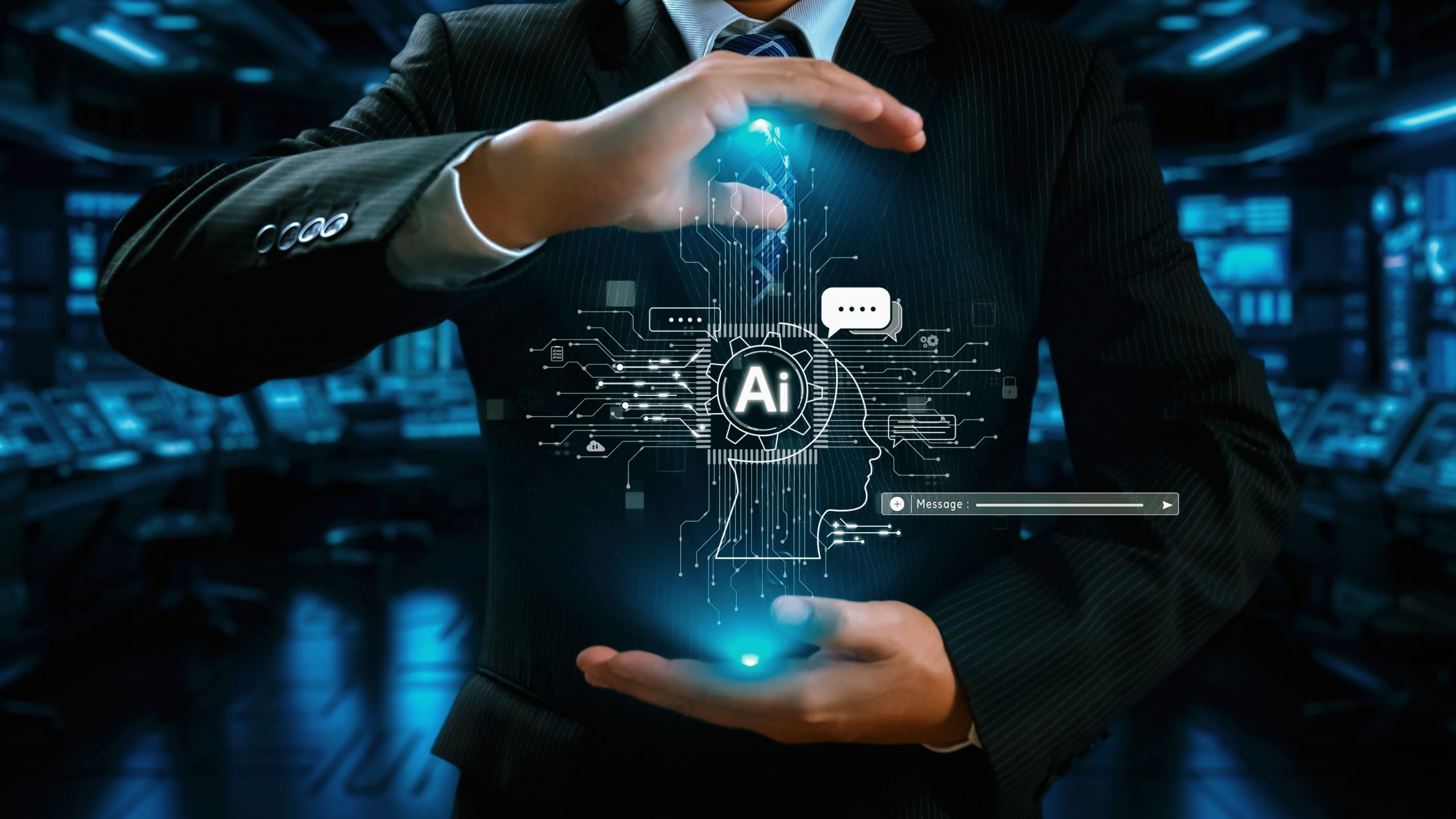I. Introduction: The Business Case for AI Transformation
Why “experimenting with AI” isn’t enough any more
In everyday operational decisions, from pricing to scheduling to customer service, AI is shifting from an experiment to the standard way business gets done. What used to be a technology pilot is now a business necessity. Companies that remain in “trial mode” risk being overtaken by competitors who are embedding AI deeply into their operations.
In other words, AI is no longer a peripheral tool; it has become a baseline capability for efficiency, insight, and innovation. Whether in manufacturing, healthcare, or financial services, leaders are learning that AI is not an optional add-on but a core enabler of how organizations function [1], [2].
The competitive shift: AI as baseline, not edge
This reality demands a new perspective. Successful organizations are not simply layering AI onto existing workflows; they are redesigning processes and decision-making systems with AI at the center. As Bain notes, many companies remain stuck in experimentation, while the real gains come when AI is used to transform how work gets done [1].
Yet, despite the momentum, most enterprises still report little measurable profit impact from their AI initiatives [2]. The reason is clear: isolated pilots and small-scale experiments rarely shift outcomes. True transformation happens when AI becomes part of the operating model itself, moving from incremental improvements to structural advantage.
In short, AI is no longer a promising project. It is a strategic imperative that determines whether businesses keep pace in an increasingly competitive market.
What this article will cover
This article will provide:
- A clear framework to translate AI strategy into measurable results
- Guidance on common pitfalls that stall progress and how to avoid them
- Real-world examples of companies achieving tangible wins with AI
The central idea is straightforward: AI is less about chasing tools and more about rethinking how business operates. Approached strategically, it enables organizations not just to experiment, but to achieve lasting impact at scale.
REFERENCES
[1] C. Whitten, S. Elk, F. Mueller, and R. Fleming, “Unsticking Your AI Transformation,” Bain & Company. Available: https://www.bain.com/insights/unsticking-your-ai-transformation/
[2] D. A. Wolfe, A. Choe, and F. Kidd, “The Architecture of AI Transformation: Four Strategic Patterns and an Emerging Frontier,” arXiv, Sep. 2025. Available: https://arxiv.org/abs/2509.02853
[3] M. Abraham, M. Colgan, S. Fisher, A. Liampoti, and C. Lynes, “How Customer Experience Is Changing Across Industries in the Age of AI,” BCG, Jun. 2025. Available: https://www.bcg.com/publications/2025/how-consumer-experience-is-changing-across-industries-in-the-age-of-ai
II. Why AI Transformation Matters (The “Why Now”)
As outlined in the introduction, AI is no longer a peripheral experiment or a set of isolated pilots. It is steadily embedding itself into how organizations make decisions, serve customers, and run core operations. The real question is not if AI matters, but why now, what makes this moment the one where adoption shifts from optional to essential?
The Market Pressure
Competitors are adopting AI faster than expected
AI adoption is accelerating across industries, shifting from isolated experiments to foundational capabilities. According to the 2025 McKinsey State of AI global survey, more than three-quarters of organizations now use AI in at least one business function, and many are redesigning workflows, elevating governance, and reconfiguring leadership roles to capture bottom-line value [1].
This rapid shift means laggards risk being overtaken. As AI becomes embedded in operations, what once was a differentiator quickly becomes table stakes. Toyota provides a clear illustration: by leveraging Google Cloud’s generative AI platform, factory teams were able to build and deploy their own models, cutting more than 10,000 hours of manual work annually while boosting efficiency [2]. Competitors willing to act boldly are setting new benchmarks, leaving slower movers exposed.
Customers increasingly expect AI-enabled experiences
Modern customers, whether internal users, B2B buyers, or end consumers, now expect personalized, anticipatory, and responsive systems. AI features like dynamic pricing, predictive recommendations, real-time support bots, and proactive alerts are ceasing to be novelty and are instead becoming baseline expectations [5].
Failing to deliver those experiences risks weakening brand perception and loyalty. Verizon has recognized this shift, deploying generative AI to anticipate the reason for 80 % of incoming calls and route them to the best agent. The initiative reduced churn and strengthened loyalty by making service interactions faster and more intuitive [3]. Customers increasingly compare every experience to such AI-enhanced benchmarks, forcing companies across industries to keep pace.
Economic headwinds: efficiency and resilience are board-level priorities
With macro uncertainty, tighter margins, and supply chain disruptions, efficiency and resilience have become board-level priorities. AI offers a lever to reduce waste, streamline decision cycles, and make operations more adaptive. In distribution and supply chain, for instance, AI is already being applied across planning, warehousing, transportation, and workforce management to build more agile and cost-effective systems [4].
Microsoft has emphasized this imperative in its enterprise work, helping clients use AI to optimize resources, improve sustainability, and boost resilience in volatile conditions [6]. Similarly, the World Economic Forum highlights AI’s growing role in global trade, where it is helping reduce customs delays, optimize logistics, and mitigate operational risk [7]. For boards and executive teams, efficiency is no longer just about cost control; it is about weathering turbulence and creating room for growth.
Taken together, these factors explain the urgency. Competitors are racing ahead, customers are raising the bar, and economic headwinds are demanding new levels of efficiency. The time for cautious “experimentation” has passed; AI transformation has become a strategic necessity.
AI as a Business Lever, Not Just Tech
Shifting the lens: from IT project to enterprise growth driver
If AI is framed only as an IT initiative, it tends to remain constrained: budgets, pilots, narrow scopes, and technical metrics. But when reframed as a strategic lever, AI becomes part of how value is created, risk is managed, and business models evolve. This shift changes who should lead (not only technologists, but business leaders), how success is measured (impact, not code), and what disciplines are central (data governance, operating model, change management).
Early adopters often treat AI as a growth driver rather than a tool. They ask not, “Which AI application should we test?” but, “Which core processes can be fundamentally reimagined with AI at the center?”
Early adopters vs cautious movers: what the numbers say
The performance gap is already evident. A McKinsey study found that 63 % of organizations report revenue increases in business units using AI, and 44 % report cost reductions, with high-performing companies far more likely to exceed 10 % improvements [8].
By contrast, enterprises that keep AI limited to disconnected pilots often report little to no measurable impact. The lesson is straightforward: moving early and embedding AI at scale materially increases the likelihood of capturing real value.
Case snapshot: AI use cases in manufacturing and logistics firms
Real-world results demonstrate how mid-sized firms, not just tech giants, are capturing efficiency gains:
- Manufacturing
AI-driven predictive maintenance, quality control, and throughput optimization have delivered cost savings of 20–40 %, reduced downtime, and improved yield. For instance, one food manufacturer eliminated unplanned machine outages using AI, boosting output by 5 % and recovering nearly USD 500,000 in weekly productivity [9]. - Logistics
AI in supply chain planning, inventory optimization, and transportation management is reducing costs and raising service levels. Research highlights that AI-driven optimization has cut logistics costs by 30 %, improved inventory turnover by 50 %, and reduced stockouts [9]. - Sustainable routing
A U.S. logistics case study demonstrated how AI-enabled eco-efficient routing reduced travel distance, fuel consumption, and operational costs while improving delivery performance [10].
These examples show that 10–20 % efficiency improvements are not theoretical, they are already being realized in practice. For mid-sized manufacturers and logistics companies, these gains can make the difference between merely surviving in competitive markets and creating room for reinvestment and growth.
REFERENCES
[1] A. Singla, A. Sukharevsky, L. Yee, M. Chui, and B. Hall, The State of AI: How Organizations Are Rewiring to Capture Value, McKinsey, Mar. 2025. Available: https://www.mckinsey.com/capabilities/quantumblack/our-insights/the-state-of-ai
[2] Google Cloud, “Real-World Generative AI Use Cases from the World’s Leading Companies,” Apr. 2025. Available: https://cloud.google.com/transform/101-real-world-generative-ai-use-cases-from-industry-leaders
[3] Reuters, “Verizon Uses GenAI to Improve Customer Loyalty,” Jun. 18, 2024. Available: https://www.reuters.com/technology/artificial-intelligence/verizon-uses-genai-improve-customer-loyalty-2024-06-18/
[4] “Harnessing the Power of AI in Distribution Operations,” McKinsey, Nov. 2024. Available: https://www.mckinsey.com/industries/industrials-and-electronics/our-insights/distribution-blog/harnessing-the-power-of-ai-in-distribution-operations
[5] M. Abraham, M. Colgan, S. Fisher, A. Liampoti, and C. Lynes, “How Customer Experience Is Changing Across Industries in the Age of AI,” BCG, Jun. 2025. Available: https://www.bcg.com/publications/2025/how-consumer-experience-is-changing-across-industries-in-the-age-of-ai
[6] Microsoft, “Harnessing AI for Resilience, Efficiency, and Sustainability,” Mar. 18, 2025. Available: https://www.microsoft.com/en-us/microsoft-cloud/blog/2025/03/18/harnessing-ai-for-resilience-efficiency-and-sustainability/
[7] World Economic Forum, Artificial Intelligence for Efficiency, Sustainability and Inclusivity in TradeTech, Jan. 14, 2025. Available: https://www.weforum.org/publications/artificial-intelligence-for-efficiency-sustainability-and-inclusivity-in-tradetech/
[8] Global AI Survey: AI Proves Its Worth, but Few Scale Impact, McKinsey, 2019. Available: https://www.mckinsey.com/featured-insights/artificial-intelligence/global-ai-survey-ai-proves-its-worth-but-few-scale-impact
[9] “9 Prominent AI Use Cases in Manufacturing,” Svitla, 2025. Available: https://svitla.com/blog/ai-use-cases-in-manufacturing/
[10] R. E. R. Shawon et al., “Designing and Deploying AI Models for Sustainable Logistics Optimization: A Case Study on Eco-Efficient Supply Chains in the USA,” arXiv, Mar. 2025. Available: https://arxiv.org/abs/2503.14556
III. Setting the Strategy (The “How”)
The forces shaping today’s business landscape (intensifying competition, heightened customer expectations, and the demand for greater resilience) leave little room for hesitation. If AI transformation is the why, then strategy is the how: the bridge between aspiration and execution. This section shifts the conversation from necessity to action, focusing on how organizations can translate intent into impact. The emphasis is on aligning AI with core business goals, charting a pragmatic roadmap for adoption, and laying the data foundations that turn short-term wins into sustainable growth.
Aligning AI With Business Goals
Start with outcomes: cost reduction, revenue growth, risk mitigation
The most successful AI programs begin by identifying tangible business outcomes rather than pursuing technology for its own sake. Cost reduction, revenue growth, and risk mitigation should not be afterthoughts; they should serve as the north star that keeps AI initiatives anchored. As Harvard Business School notes, ensuring that AI aligns with organizational strategy requires linking implementations to clear financial and operational objectives [1].
This outcome-first mindset distinguishes strategic adopters from those drawn into “AI for AI’s sake.” Without alignment, investments risk producing interesting demonstrations that fail to influence the bottom line.
The myth of “AI for AI’s sake”
Many AI initiatives emerge from technical curiosity: projects launched because the technology is available, rather than because a pressing business challenge exists. That path often leads to failure. According to Bain & Company, programs that succeed differ because they are tied directly to customer value or metrics already important to leadership [2].
By contrast, organizations that link AI to visible business problems, such as reducing churn, optimizing inventory, or improving underwriting accuracy, are far more likely to see sustained adoption and enterprise-level impact.
Linking AI to KPIs executives already care about
Once outcomes are defined, the next step is mapping them to executive KPIs. For example:
- Cost reduction → margin expansion, operating expense ratio, or cost per unit
- Revenue growth → upsell rates, conversion lift, average order value
- Risk and compliance → fraud losses, error rates, downtime
Frameworks such as GQM+Strategies (Goal–Question–Metric) help cascade high-level objectives into measurable indicators [3]. This ensures that AI is embedded in the organization’s performance system, not isolated in a technology silo.
Use case (retail):
A large global retailer implemented AI-driven demand forecasting, linked directly to KPIs such as stockout frequency and weeks of supply. Within a year, the company reduced inventory carrying costs by 15 % and stockouts by 10 % [4].
Building the Roadmap
Phased adoption: Discovery → Integration → Amplification → Transformation
Organizations that succeed rarely attempt to leap from experimentation to enterprise transformation in a single move. Instead, they follow phased adoption:
- Discovery — assess business challenges, data readiness, and opportunities.
- Integration — embed AI into one or two targeted use cases with cross-functional sponsorship.
- Amplification — extend solutions to adjacent functions and broaden scope.
- Transformation — rearchitect the operating model so AI is embedded in core business processes.
Accenture research finds that only about 8 % of companies have reached true enterprise-scale AI, with most stalling because they skip phases or neglect foundational capabilities [5].
Identifying quick wins vs long-term bets
Balancing immediate momentum with structural change is key. Quick wins, such as deploying AI-powered chatbots for customer service, demonstrate early value and secure leadership support. Long-term bets, like redesigning end-to-end sales processes around AI, require deeper investment and broader change. Both are critical, but they differ in resource requirements and expected payoff horizons.
How to avoid pilot purgatory (projects that never scale)
A common obstacle is “pilot purgatory,” where promising experiments fail to scale. Research shows that for every 33 AI prototypes built, only 4 reach production [6]. Contributing factors include unclear ownership, inadequate governance, and lack of integration planning.
Avoiding this requires:
- Defining scaling criteria from the outset
- Assigning joint business and technology ownership
- Planning integration and operations early
- Securing executive sponsorship with transparent metrics
- Embedding governance and monitoring practices
Harvard Business Review emphasizes that AI projects frequently fail when they are not tied to customer value or when organizations lack a clear scaling pathway [2].
Use case (financial services)
A European bank broke out of pilot purgatory by tying AI to fraud detection KPIs. By securing sponsorship from both risk management and IT, and by integrating AI into the fraud workflow rather than running it as a parallel experiment, the bank reduced false positives by 20 % and cut investigation costs by millions annually [7].
Data as the Foundation
Good AI starts with clean, structured, well-governed data
Even the most advanced model cannot perform without high-quality data. In Accenture’s survey, 70 % of companies acknowledged that data challenges were holding back AI progress [5]. Poor data governance, inconsistent definitions, and fragmented ownership are common barriers.
Practical data strategy: where most companies stumble
Organizations often fail by attempting to collect every dataset upfront or by postponing governance until later. A more effective strategy is prioritizing data domains tied directly to chosen AI use cases. Starting with structured, high-value sources creates focus and ensures that governance evolves alongside adoption.
Use case (telecommunications):
A major telecom operator established a robust data-governance framework over its network performance data. Once stabilized, this enabled predictive maintenance models that reduced network outages by 20 % and delivered multimillion-dollar annual savings [8].
Building a data advantage instead of a data swamp
The difference between a data swamp and a data advantage lies in governance and design. Organizations that enforce standards, track lineage, automate cleaning, and incentivize cross-functional data sharing position themselves for sustainable AI success.
Use case (technology services): Netflix implemented a decentralized “data mesh” model, empowering domain teams to own and serve data as products. This approach eliminated bottlenecks from a centralized data lake and accelerated AI-driven personalization at scale [9].
REFERENCES
[1] Harvard Business School, “Aligning Artificial Intelligence with Business Strategy,” HBS Online. Available: https://online.hbs.edu/blog/post/aligning-artificial-intelligence-with-business-strategy
[2] C. Whitten, S. Elk, F. Mueller, and R. Fleming, Unsticking Your AI Transformation, Bain & Company. Available: https://www.bain.com/insights/unsticking-your-ai-transformation
[3] V. Basili, “GQM+Strategies: Aligning Business Goals with Software Measurement,” Fraunhofer IESE. Available: https://www.iese.fraunhofer.de/en/services/research-transfer/gqm-strategies.html
[4] A. Singla, A. Sukharevsky, L. Yee, M. Chui, and B. Hall, The State of AI: How Organizations Are Rewiring to Capture Value, McKinsey, Mar. 2025. Available: https://www.mckinsey.com/capabilities/quantumblack/our-insights/the-state-of-ai
[5] Accenture, “The Art of AI Maturity: Advancing from Practice to Performance,” Accenture Research, 2022. Available: https://www.accenture.com/us-en/insights/artificial-intelligence/ai-investments
[6] M. Gupta, “Why AI Pilots Fail to Scale,” VentureBeat, Nov. 2022. Available: https://venturebeat.com/ai/why-ai-pilots-fail-to-scale
[7] McKinsey & Company, “How AI Is Helping Banks Combat Fraud,” Oct. 2023. Available: https://www.mckinsey.com/industries/financial-services/our-insights/how-ai-is-helping-banks-combat-fraud
[8] Ericsson, “How AI Is Used in Telecom Predictive Maintenance,” Apr. 2024. Available: https://www.ericsson.com/en/blog/2024/4/ai-predictive-maintenance-telecom
[9] Z. Dehghani, “Data Mesh Principles and Logical Architecture,” ThoughtWorks, 2020. Available: https://martinfowler.com/articles/data-mesh-principles.html
IV. Challenges Leaders Must Navigate
The strategy outlined previously, anchoring AI to business outcomes, charting a roadmap, and building strong data foundations, provides a solid blueprint. But blueprints do not build transformations on their own. Turning plans into progress inevitably brings real-world hurdles. To succeed, leaders must anticipate and address challenges across three interdependent domains: people, technology, and governance. Each comes with risks that, if left unmanaged, can stall momentum. Navigating them with foresight, clarity, and discipline is what turns strategy from intention into lasting impact.
The People Side
Change management: winning hearts and minds, not just budgets
Organizational change remains the most cited barrier to transformation efforts. According to Prosci’s research, although 84 % of change practitioners report familiarity with AI, only 39 % integrate AI in change work, signaling a gap between awareness and adoption [1]. Many transformation programs fail because leadership underestimates the depth of human resistance. Booz Allen emphasizes that AI adoption requires open communication, identification of resistance points, and continuous engagement with stakeholders [2].
AI can support change management (e.g., sentiment analysis to detect anxiety, personalized messaging to different groups) but it does not replace leadership. For example, an insurance firm implemented AI-augmented process mining to automate claim part identification (previously manual) while concurrently deploying regular workshops, feedback loops, and change champions. This dual approach helped sustain staff engagement and reduce friction as the technical solution scaled [3].
The culture shift: curiosity, experimentation, and cross-functional collaboration
Adopting AI demands more than procedural changes; it requires cultural evolution. Teams must value curiosity, tolerate small failures, and collaborate horizontally across disciplines (data, operations, product, compliance). Organizational norms that reward silos, risk aversion, or turf protection must be challenged. McKinsey argues that AI in the workplace is not a technology problem, it is a business challenge that calls for rewiring the culture and aligning people around new modes of working [4].
Some leading organizations create internal “innovation labs” or cross-functional squads that can experiment, then diffuse successful prototypes into business units. These labs often serve as safe spaces for testing ideas without immediate pressure of ROI, while downstreaming validated patterns into the core.
Reskilling and workforce planning for an AI-enabled future
AI will shift, not eliminate, much of the workforce. Many roles will change in scope, while new hybrid human+machine roles emerge. According to Booz Allen, organizations must plan for workforce upskilling, role redesign, and talent mobility from the start [2].
Use Case (healthcare sector)
A real-world example comes from the healthcare administration sector: Omega Healthcare used AI-driven document processing to reduce manual workload by 15,000 hours per month, and redeployed staff toward strategic oversight and exception management rather than outright layoffs. The thoughtful approach to workforce transition helped maintain morale and enabled faster adoption [5].
The Technology Side
The “build vs buy” debate for AI solutions
One of the early technology dilemmas is whether to build custom AI systems or buy pre-built modules. Buying accelerates deployment and reduces initial risk, while building allows customization and differentiation. Many firms adopt a hybrid approach: purchase foundational models or services, and build tailored extensions or domain-specific layers.
That said, even “built” solutions carry maintenance burden. Technical teams must plan for lifecycle management, performance drift, updates, and integration with evolving infrastructure. A thoughtful platform strategy that balances uniqueness and maintainability is essential.
Integration with legacy systems: messy but solvable
Most enterprises run on legacy systems, ERP, mainframes, monolithic databases, that resist modern AI layering. Rather than complete rip-and-replace, many organizations adopt incremental integration: exposing APIs, building wrapper layers, or deploying middleware that bridges models and legacy apps.
A compelling example comes from banking: a generative AI method was used to examine thousands of past incident logs and change-request data across legacy modules. That approach found about 70 % of recurring failures traced to deeper code issues rather than external factors, enabling the bank to correct root causes proactively rather than repeatedly applying superficial patches [6].
Avoiding vendor lock-in while staying innovative
Dependency on a single vendor for AI infrastructure or models introduces strategic risk. Vendor lock-in can make future flexibility costly—every model swap or update may require rework. In the generative AI context, vendor lock-in is particularly acute: few systems are truly plug-and-play across underlying large language models, making migrations non-trivial [7].
Some organizations combat this via architectural abstractions such as AI middleware, which works as a neutral layer to decouple business logic from model implementation details. This lets teams switch or upgrade models without rewriting the full stack [8]. Vendor contracts should include portability terms, data export rights, and modular interfaces to enable flexibility.
The Governance Side
Security and compliance in an AI world
AI systems bring expanded attack surfaces: model poisoning, adversarial inputs, data leaks, and unauthorized inference. According to a 2025 analysis, security and compliance are among the top obstacles delaying AI adoption in enterprises [9]. Any AI initiative must be designed from inception with security, logging, access controls, encryption, anomaly detection, and incident response.
Additionally, multi-jurisdictional compliance (e.g., GDPR, AI Act, industry-specific rules) further complicates deployment. Bridges between AI/ML teams and legal, risk, or regulatory functions often remain underdeveloped, causing bottlenecks.
Bias, transparency, and ethical risks
AI models can inadvertently perpetuate or magnify bias. Regulatory scrutiny and public trust demand explainability, fairness testing, auditability, and recourse processes. Bridgepoint Consulting highlights that governance is essential to prevent bias, protect privacy, and foster transparency in how AI decisions are made [10].
One illustrative financial services example: a major European bank’s fraud detection model was adjusted mid-deployment after audits revealed disproportionate false positives for certain customer segments. Governance protocols required review, transparency, and bias mitigation measures.
Transparency also includes traceability and explainability. Governance structures should require logging of model decisions, versioning, drift detection, and mechanisms for human override or appeal.
Practical governance frameworks that don’t strangle innovation
Governance should act as an enabler, not a drag. Common design patterns include:
- Tiered governance: apply light oversight to low-risk use cases, stricter review for high-impact ones
- Guardrails, not gates: define rules and guidelines, then allow modular approvals
- Model review boards: cross-functional teams that assess risk, alignment, and compliance
- Continuous monitoring: automating drift detection, performance metrics, and feedback loops
- Ethics councils or AI oversight committees: ensuring that future use aligns with company values and regulatory trends
Notably, Johnson & Johnson learned through experience that only about 10–15 % of early AI projects delivered 80 % of value, prompting a shift from centralized governance to distributed decision-making in business functions [11]. That pivot illustrates the importance of pragmatic governance: strong but flexible.
Red Hat also stresses that transparency, open ecosystems, and flexible architectures are essential to avoid turning governance into a bottleneck [12].
REFERENCES
[1] Prosci, “AI in Change Management: Early Findings,” Prosci Blog, Jan. 2024. Available: https://www.prosci.com/blog/ai-in-change-management-early-findings
[2] Booz Allen, “Change Management for Artificial Intelligence Adoption,” Booz Allen Insights. Available: https://www.boozallen.com/insights/ai-research/change-management-for-artificial-intelligence-adoption.html
[3] S. Khayatbashi, V. Sjölind, A. Granåker, A. Jalali, “AI-Enhanced Business Process Automation: A Case Study in the Insurance Domain Using Object-Centric Process Mining,” arXiv, Apr. 2025. Available: https://arxiv.org/abs/2504.17295
[4] McKinsey, “AI in the Workplace: A Report for 2025,” McKinsey Digital. Available: https://www.mckinsey.com/capabilities/mckinsey-digital/our-insights/superagency-in-the-workplace-empowering-people-to-unlock-ais-full-potential-at-work
[5] Business Insider, “How Omega Healthcare Uses AI to Automate Billing and Claims,” Business Insider, 2024. Available: https://www.businessinsider.com/omega-healthcare-ai-document-processing-automation
[6] S. Jin, Z. Bei, B. Chen, Y. Xia, “Breaking the Cycle of Recurring Failures: Applying Generative AI to Root Cause Analysis in Legacy Banking Systems,” arXiv, Nov. 2024. Available: https://arxiv.org/abs/2411.13017
[7] W. Alshikh, “Navigating the Challenges of Generative AI and ‘Vendor Lock-In’ in Enterprises,” Writer.com, Dec. 2024. Available: https://writer.com/engineering/vendor-lock-in-generative-ai/
[8] W. Fisher, “How AI Middleware Solves the Vendor Lock-In Problem,” VKTR, May 2025. Available: https://www.vktr.com/digital-workplace/how-ai-middleware-solves-the-vendor-lock-in-problem/
[9] The Hacker News, “AI Adoption in the Enterprise: Breaking Through the Security and Compliance Gridlock,” Apr. 2025. Available: https://thehackernews.com/2025/04/ai-adoption-in-enterprise-breaking.html
[10] Bridgepoint Consulting, “AI Governance & Risk Management: Importance & Components,” Bridgepoint, 2025. Available: https://bridgepointconsulting.com/insights/ai-governance-risk-management-importance-components-key-considerations/
[11] Wall Street Journal, “Johnson & Johnson Pivots Its AI Strategy,” Apr. 2025. Available: https://www.wsj.com/articles/johnson-johnson-pivots-its-ai-strategy-a9d0631f
[12] Red Hat, “The Future of AI Governance: Transparency and Trust,” Red Hat Blog, Jul. 2025. Available: https://www.redhat.com/en/blog/the-future-of-ai-governance-transparency-and-trust
V. Wins to Aim For (and Measure)
The last section explored the hurdles that can slow AI transformation, across people, technology, and governance. Clearing those obstacles is essential, but it is the outcomes that ultimately prove the effort worthwhile. Sustaining momentum depends on delivering visible, measurable wins that matter to the business and inspire confidence across the organization. These wins tend to surface in three powerful areas: sharper operational efficiency, more informed decision-making, and customer experiences that set new standards of value.
Operational Efficiency
Operational efficiency is often the first domain where AI delivers visible returns. By automating processes, improving forecasts, and anticipating failures, organizations can unlock cost and time savings. The key is to tie those gains to metrics that leadership already tracks, cycle times, throughput, downtime reduction, and operating costs.
Examples: process automation, demand forecasting, predictive maintenance
- Amazon’s AI-Driven Supply Chain:
Amazon has woven AI into demand forecasting, inventory optimization, and logistics. The system reduces excess stock, prevents shortages, and routes deliveries more intelligently, yielding faster fulfillment and lower costs [1]. - Eco-Efficient Logistics in U.S. Supply Chains:
A study on sustainable logistics showed that AI-based routing and forecasting models reduced travel distance and time, cutting fuel use and costs while improving reliability [2].
Tangible ROI metrics
Efficiency improvements resonate most when expressed in concrete terms:
- Reduction in unplanned downtime (%)
- Hours of manual work eliminated
- Throughput increase (units per hour)
- Lower logistics cost per unit
Case example: logistics firm shaving days off delivery times
A logistics provider applied AI route optimization to compress delivery windows and improve punctuality. Studies suggest optimization can reduce overall delivery time by up to 25 %, and last-mile delivery by up to 40 % [3]. Amazon’s AI-driven network achieved similar results, boosting delivery capacity by 75 % compared with older approaches [1].
When improvements are framed with metrics such as “deliveries per driver per day” or “late deliveries per 1,000,” AI is no longer an abstract concept, it becomes a proven lever of operational performance.
Smarter Decision-Making
Efficiency gains matter, but real differentiation comes from sharper decisions, particularly in environments marked by volatility or complexity. Here, AI functions best as a strategic copilot, giving leaders foresight without replacing judgment.
AI as an executive copilot: augmenting human judgment
AI highlights anomalies, models scenarios, and suggests options leaders may not otherwise see. It informs decisions without automating them, enhancing human intuition with data-driven clarity.
Real-time dashboards and predictive insights
- Executive Dashboard in Financial Services:
A wholesale bank worked with XDuce to build an AI-enhanced dashboard that unified fragmented data and surfaced predictive insights. The system cut decision latency by 30 % and reduced task errors by a factor of five [4].
- Fintech Fraud Intelligence Dashboards:
In fintech, AI-driven dashboards visualize fraud patterns across time and geography, allowing teams to recalibrate detection models proactively [5].
How AI strengthens, not replaces, leadership instincts
AI works best when paired with human discernment. In underwriting or supply planning, AI quantifies trade-offs, while executives still decide. In insurance claims, AI routes cases and flags exceptions, while adjusters resolve the most complex scenarios. The outcome is consistency, fewer errors, and shorter cycle times.
When organizations measure outcomes such as decision turnaround time, forecast accuracy, and reduction in rework, they demonstrate that AI is not a replacement for judgment, it is a force multiplier.
Customer Experience Transformation
The most visible, and often most celebrated, wins come from customer-facing transformation. AI allows organizations to deliver the personalization, responsiveness, and proactive service that modern customers increasingly expect.
Personalized engagement at scale
- AI-Powered Self-Service in Financial Services:
One provider introduced AI-driven chat and self-service across tax inquiries, loan servicing, and refunds. More than half of all interactions were handled without a human agent, speeding resolution and reducing workload [6].
- Dynamic Micro-Personalization in Banking:
Banks deploying AI to tailor offers and services report significantly higher engagement and conversion, as customers respond more positively to experiences that feel personally relevant [7].
Faster service, proactive solutions, and intelligent self-service
Beyond chatbots, predictive tools transform service into preemptive engagement. Alerts can notify customers before disruptions occur, whether in energy systems, industrial machinery, or financial accounts.
Industry examples
- Financial Services:
AI chatbots and recommendation engines improve satisfaction and expand cross-sell opportunities. - Manufacturing / Industrial Services:
Predictive maintenance alerts sent to clients prevent unexpected downtime and reinforce trust. - Energy and Utilities:
AI anomaly detection in field equipment identifies risks early, improving safety and reliability.
AWS highlights that AI-powered hyper-personalization can increase engagement rates by 40 % and revenue by 35 % [8]. Similarly, AI-driven customer intelligence platforms help organizations reduce support volume, improve first-response times, and raise Net Promoter Scores [6].
By framing results as “20 % higher retention,” “45 % faster resolution,” or “35 % revenue lift from personalization,” leaders can showcase AI as a tangible driver of competitive advantage.
REFERENCES
[1] Sifted, “How Amazon Is Using AI To Become the Fastest Supply Chain in the World,” Jul. 2024. Available: https://sifted.com/resources/how-amazon-is-using-ai-to-become-the-fastest-supply-chain-in-the-world/
[2] R. E. R. Shawon et al., “Designing and Deploying AI Models for Sustainable Logistics Optimization: A Case Study on Eco-Efficient Supply Chains in the USA,” arXiv, Mar. 2025. Available: https://arxiv.org/abs/2503.14556
[3] Anton Dubov, “AI in Logistics Efficiency: Revolutionizing Transportation,” LinkedIn Pulse, 2025. Available: https://www.linkedin.com/pulse/ai-logistics-efficiency-revolutionizing-delivery-anton-dubov-fdzvc
[4] XDuce, “Interactive Executive Dashboard for Real-Time Financial Insights.” Available: https://xduce.com/case-studies/interactive-executive-dashboard-for-real-time-financial-insights/
[5] Multishoring, “AI-Powered Business Intelligence Dashboards for Fintech,” Mar. 2025. Available: https://multishoring.com/blog/ai-powered-business-intelligence-dashboards-for-fintech-revolutionizing-decision-making/
[6] NICE, “How AI is Powering Next-Gen Customer Care in Financial Services,” Mar. 2025. Available: https://www.nice.com/blog/how-ai-is-powering-next-gen-customer-care-in-financial-services
[7] SuperAGI, “Dynamic Micro-Personalization in Banking: Case Studies on AI-Driven Customer Experiences,” Jun. 2025. Available: https://superagi.com/dynamic-micro-personalization-in-banking-case-studies-on-ai-driven-customer-experiences/
[8] AWS, “Hyper-Personalization Using AI-Powered Marketing.” Available: https://aws.amazon.com/executive-insights/content/hyper-personalization-using-ai-powered-marketing/
VI. Leading the AI-Driven Business
The wins outlined earlier, improvements in efficiency, decision-making, and customer experience, show how AI can generate real business value. Yet turning those gains into lasting advantage requires more than technology alone; it demands leadership. Without active direction from the top, AI risks remaining a collection of isolated successes rather than a sustained transformation. This section turns to the leadership imperatives and organizational design choices that make the difference: how senior executives foster accountability and experimentation, and how enterprises weave AI into the fabric of daily operations instead of treating it as an add-on.
Leadership Imperatives
Why the CEO/COO/CFO must stay in the driver’s seat
AI transformation cannot be delegated solely to IT or data teams. When the CEO, COO, and CFO remain visibly involved, they send a clear signal that AI is a strategic priority. Harvard Business Review highlights that successful strategies are rarely championed by a single executive; they depend on broad C-suite engagement [1].
Leadership presence also ensures that AI remains tied to business outcomes rather than technical curiosity. Former Cisco CEO John Chambers has argued that the rapid pace of AI requires leaders to reinvent themselves every year, or risk falling behind [2].
The point is reinforced by Intel’s reorganization in 2025. CEO Lip-Bu Tan streamlined reporting structures and appointed a Chief AI Officer who reports directly to him, positioning AI alongside Intel’s core business functions [3]. Moves like these make AI not just another initiative, but a board-level driver of strategy.
Creating a culture of accountability and experimentation
AI thrives in cultures that balance curiosity with rigor. Leaders must encourage experimentation while setting clear accountability for outcomes. McKinsey notes that AI is accelerating how strategies are tested and refined, but its success hinges on leaders fostering environments where teams can test, learn, and adjust at speed [4].
The experience of Johnson & Johnson offers a cautionary yet constructive lesson. The company initially launched close to 900 AI use cases, only to discover that a small fraction, about 10 to 15 %, generated most of the value. Leadership responded by shifting governance from a central team to business functions, ensuring accountability for outcomes rested closer to where impact was created [5]. The result was fewer initiatives, but greater focus and measurable returns.
Balancing bold moves with pragmatic execution
The strongest AI leaders combine bold ambition with disciplined execution. Large “moonshot” initiatives capture imagination, but smaller, dependable wins build momentum and credibility. Both are necessary.
As recent research on the Architecture of AI Transformation points out, scaling AI requires more than adding tools, it calls for rethinking governance, data architecture, and organizational roles [6]. Leaders who take a portfolio view, balancing big bets with pragmatic projects, are better equipped to sustain progress. This approach keeps enthusiasm high without losing sight of operational realities.
Building an AI-Ready Organization
Organizational design: from siloed initiatives to enterprise AI strategy
Sustainable transformation requires moving from scattered pilots to an enterprise-wide strategy. This means combining central coordination with local autonomy: a core team that sets standards and builds shared infrastructure, alongside business units empowered to innovate.
AI can even reshape how organizations think about structure itself. For example, a pharmaceutical company used a “digital twin” of its organizational chart to simulate how R&D and commercial teams might integrate following an acquisition. The model uncovered bottlenecks and, once acted upon, helped cut new product development time by 40 % [7].
In Europe, an infrastructure firm redesigned workflows around AI integration. By assigning repetitive analysis tasks to models, employees were able to focus on creative and relational work, making the organization more agile while reinforcing the value of human judgment [8].
Embedding AI into workflows, not bolting it on
True advantage comes when AI is part of the workflow, not an external overlay. Insights must flow directly into execution systems so they change how work gets done. As one study emphasizes, closing the loop between analytics and action is critical to realizing value [9].
An insurance company provides a practical example. By embedding object-centric process mining into claims handling, it automated the identification of claim parts that had previously required manual work. This wasn’t a separate system; it was woven into the process itself. The result was higher throughput, reduced variation, and more consistent outcomes [10].
When AI is integrated this way, adoption rises and the technology becomes invisible, a seamless part of daily work.
Sustaining transformation: feedback loops, measurement, and iteration
AI transformation is not a one-time event but a continuous cycle. Models drift, customer expectations evolve, and competitors move quickly. Organizations that succeed build feedback loops to measure performance, adapt workflows, and retrain models regularly.
Dashboards that track adoption, ROI, and risks are as important as the models themselves. Continuous improvement ensures AI initiatives remain relevant and valuable. Over time, businesses that institutionalize this learning loop become more adaptive, more predictive, and better positioned to capture new opportunities.
REFERENCES
[1] J. Winsor, J. Stave, and R. Kurt, “Your AI Strategy Needs More Than a Single Leader,” Harvard Business Review, Aug. 2025. Available: https://hbr.org/2025/08/your-ai-strategy-needs-more-than-a-single-leader
[2] “Leaders in AI Need to Reinvent Themselves Every Year, Says Cisco’s Former CEO,” Business Insider, May 2025. Available: https://www.businessinsider.com/leaders-ai-reinvent-every-year-cisco-john-chambers-2025-5
[3] “Intel CEO Lip-Bu Tan Flattens Leadership Structure, Names New AI Chief,” Reuters, Apr. 2025. Available: https://www.reuters.com/technology/intel-ceo-lip-bu-tan-streamlines-leadership-team-names-new-technology-chief-memo-2025-04-17/
[4] “How AI Is Transforming Strategy Development,” McKinsey, Feb. 2025. Available: https://www.mckinsey.com/capabilities/strategy-and-corporate-finance/our-insights/how-ai-is-transforming-strategy-development
[5] “Johnson & Johnson Pivots Its AI Strategy,” Wall Street Journal, Apr. 2025. Available: https://www.wsj.com/articles/johnson-johnson-pivots-its-ai-strategy-a9d0631f
[6] D. A. Wolfe, A. Choe, and F. Kidd, The Architecture of AI Transformation: Four Strategic Patterns and an Emerging Frontier, arXiv, Sep. 2025. Available: https://arxiv.org/abs/2509.02853
[7] “Transforming Organizational Structures: Harnessing AI for the Future of Work,” Functionly. Available: https://www.functionly.com/orginometry/ai-assisted-org-design/transforming-organizational-structures-harnessing-ai-for-the-future-of-work
[8] P. Oliveira et al., “AI Integration in Organisational Workflows: A Case Study,” Information (MDPI), 2025. Available: https://www.mdpi.com/2078-2489/16/9/764
[9] Moses Blessing et al., “Embedding AI-Driven Insights into Enterprise Workflows: Closing the Loop Between Analytics and Action,” ResearchGate, Jul. 2025. Available: https://www.researchgate.net/publication/393661887_Embedding_AI-Driven_Insights_into_Enterprise_Workflows_Closing_the_Loop_Between_Analytics_and_Action
[10] S. Khayatbashi, V. Sjölind, et al., “AI-Enhanced Business Process Automation: A Case Study in the Insurance Domain Using Object-Centric Process Mining,” arXiv, Apr. 2025. Available: https://arxiv.org/abs/2504.17295
VI. Conclusion: Turning Strategy Into Wins
AI has shifted from experiment to expectation. This post traced the full arc: why transformation matters, how to craft a strategy, the challenges leaders must navigate, and the wins (greater efficiency, sharper decisions, and richer customer experiences) that prove the value is real.
Threaded through every stage is a single truth: leadership is the multiplier. Technology provides the tools, but people provide the transformation. When CEOs, COOs, and CFOs remain in the driver’s seat, when cultures balance accountability with experimentation, and when AI is woven into workflows rather than bolted on, results endure and scale [1][2].
The call to action is clear: start small, think big, move fast. Anchor pilots in real business outcomes, double down on what works, and keep momentum before competitors close the gap [3].
In the end, building an AI-driven business is less about chasing the latest model and more about leading with vision and conviction. Those who treat AI as a catalyst for culture, structure, and execution will not only capture near-term gains: they will build the kind of sustained advantage that defines industry leaders.
REFERENCES
[1] Harvard Business Review, “Your AI Strategy Needs More Than a Single Leader,” Aug. 2025. Available: https://hbr.org/2025/08/your-ai-strategy-needs-more-than-a-single-leader
[2] Wall Street Journal, “Johnson & Johnson Pivots Its AI Strategy,” Apr. 2025. Available: https://www.wsj.com/articles/johnson-johnson-pivots-its-ai-strategy-a9d0631f
[3] BCG, “How Four Companies Use AI for Cost Transformation,” 2025. Available: https://www.bcg.com/publications/2025/how-four-companies-use-ai-for-cost-transformation















